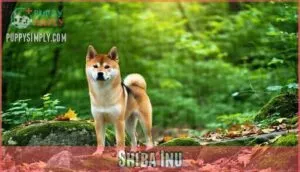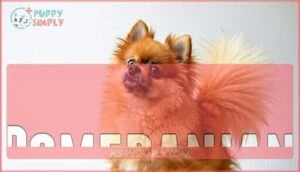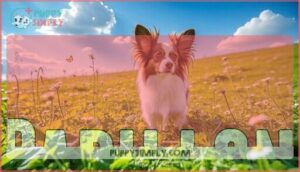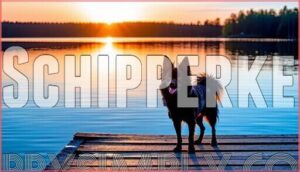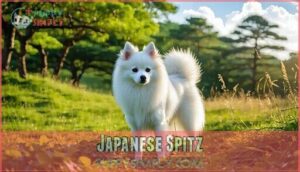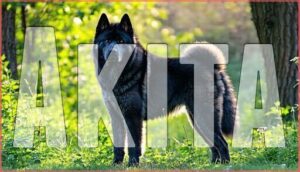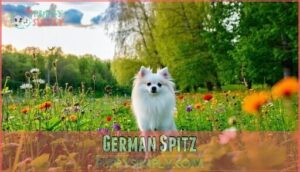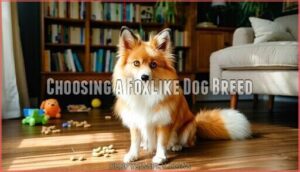This site is supported by our readers. We may earn a commission, at no cost to you, if you purchase through links.

Breeds like the Shiba Inu, Finnish Spitz, and Pomeranian feature pointed triangular ears, narrow muzzles, and bushy tails that mirror their wild fox cousins.
These fox-like traits emerged through selective breeding over thousands of years, emphasizing alert expressions and compact builds.
Red coats ranging from russet to copper are common among these breeds, along with almond-shaped eyes that complete the foxy illusion.
From tiny Papillons to medium-sized Basenjis, these domesticated companions capture the wild fox’s distinctive appearance while offering unique temperaments and care requirements that make each breed special.
Table Of Contents
Key Takeaways
- You’ll find fox-like breeds ranging from tiny 4-pound Pomeranians to large 100-pound Akitas, so there’s a perfect size match for any living situation or family preference.
- These breeds typically require more grooming than average dogs due to their thick double coats that shed heavily twice yearly, especially spitz-type breeds like Shiba Inus and Finnish Spitz.
- You should expect independent, intelligent personalities that can be challenging to train – breeds like Shiba Inus are notoriously stubborn, while others like Papillons are more eager to please.
- Your lifestyle compatibility matters more than appearance – consider factors like energy levels, living space, and experience with dogs since these breeds often have strong prey drives and specific exercise needs.
Why Some Dogs Resemble Foxes
You’ll notice many dogs share foxes’ pointed ears, narrow muzzles, and bushy tails because both species evolved from the same ancient canid ancestors millions of years ago.
Ancient canid DNA connects your dog’s foxy features to millions of years of shared evolution
Humans have also selectively bred certain dog breeds to emphasize these fox-like features, creating companions that capture the wild fox’s alert expression and fiery coat colors.
Evolutionary Origins of Canids
The canine family tree stretches back millions of years to Miacis Evolution, a weasel-like mammal from 60 million years ago.
Canid Ancestors diverged around 40 million years ago, eventually leading to Eurasian Origins of modern wolves.
Through Fossil Records, you’ll discover that Wolf Domestication created the foundation for today’s fox like dogs and canine fox breeds through selective breeding rather than direct dog fox hybrid crosses.
Shared Physical Traits With Foxes
Dogs that look like foxes share striking physical features that’ll make you do a double-take.
You’ll notice their fox like ears standing alert and triangular, pointed muzzles that create angular faces, and bushy tails that curl or sweep gracefully.
These fox faced dogs often sport red coats ranging from russet to copper.
Their almond-shaped eyes and compact builds complete the foxy illusion that makes these canine fox breeds so enchanting.
Some breeds exhibit similar characteristics to husky lookalikes due to their thick double coats and distinctive markings.
Human Influence on Foxlike Breeds
Since humans began selecting friendlier foxes over 58 generations, selective breeding has dramatically shaped dogs that look like foxes.
Through targeted foxlike selection and breeding methods, you’ll find fox faced dogs displaying pointed ears, red coats, and alert expressions.
Human interaction and training techniques have enhanced these fox like canine traits, while ownership responsibilities include understanding these dog breeds like foxes require specific care for their unique characteristics.
The foxlike dog breeds have distinct characteristics, such as fox like appearance, that set them apart from other breeds.
Small Dogs That Look Like Foxes
If you’re looking for a compact companion with foxlike charm, small breeds offer the perfect combination of portable size and wild appeal.
These pint-sized dogs pack all the fox features you love into a manageable package that fits any living situation.
Shiba Inu
With Japanese origins dating back 7,000 years, the Shiba Inu perfectly embodies fox traits through its triangular ears, curled tail, and compact build.
This ancient breed’s dog domestication history reflects primitive genetic roots, making it one of Japan’s most treasured fox looking dogs. Their spirited independence and dense double coat showcase why dog breeds like foxes captivate enthusiasts seeking fox like canine companions.
The Shiba Inu’s unique characteristics and behavior can be understood through native Japanese breeds information.
Pomeranian
If the Shiba Inu’s boldness caught your eye, the Pomeranian’s fox dog appearance will steal your heart.
This tiny fluff ball sports a foxy face, triangular ears, and a bushy tail.
Pomeranian care involves regular dog grooming and patient pet training, with a playful spirit and rich breed history, these fox type dogs bring big personality in a small package.
Papillon
Unlike the fluffy Pomeranian, you’ll find the Papillon’s elegance in its butterfly-like ears and refined features.
Their alert expression and graceful build make Papillon care rewarding for active families.
With proper dog training, these fox type dogs excel in agility sports, combining their natural fox traits with remarkable intelligence and athletic ability, creating that coveted fox dog appearance through striking wing-shaped ears and darker markings around their intelligent brown eyes.
Schipperke
Originally bred in Belgium for rodent control on barges, the Schipperke displays classic fox traits through its sharp facial features and bushy tail.
This small fox dog’s triangular ears and pointed muzzle create an unmistakably foxy silhouette, though most come in black rather than red.
Their Belgian origins shaped these energetic, mischievous companions into alert watchdogs. While small in size, Schipperkes possess the confidence and curiosity that makes dogs resembling foxes so charming to owners seeking spirited personalities.
Many owners of small breed dogs consider them ideal pets due to their small space needs.
Volpino Italiano
This Italian spitz breed captures hearts with its foxlike features and spirited personality.
The Volpino Italiano’s pointed ears, narrow muzzle, and fluffy white coat create striking resemblance to arctic foxes.
These compact companions weigh just 8-16 pounds but pack tremendous energy into their small frames.
You’ll need consistent training tips and daily activity to manage their independent nature and high exercise requirements.
Japanese Spitz
You’ll find the Japanese Spitz shares breed origins with the German Spitz, creating dogs with fox features through selective breeding.
These fox inspired dogs display temperament traits like loyalty and intelligence, making them excellent companions.
Their double coat requires regular grooming needs to prevent matting.
While generally healthy, some health concerns include patellar luxation. Their moderate activity levels suit most families seeking dog breeds with distinctive fox resemblance characteristics.
Medium Dogs With Foxlike Features
Medium-sized dogs offer the perfect balance between the compact charm of smaller foxlike breeds and the majestic presence of larger ones.
You’ll find these breeds typically weigh between 20-50 pounds and showcase the classic fox features of pointed ears, narrow muzzles, and alert expressions that make them irresistible companions.
Finnish Spitz
Known for its striking resemblance to a wild red fox, the Finnish Spitz showcases classic Spitz temperament through its alert expression and confident stance.
This breed’s Finnish origins trace back to ancient hunting traditions, where selective breeding enhanced their natural abilities.
Key characteristics include:
- Barking tendencies – Nicknamed the "Barking Bird Dog" for vocal tracking skills
- Hunting heritage – Originally developed for bird hunting in Finland’s forests
- Fox dog mix appearance – Triangular ears, pointed muzzle, and fiery red coat
The Finnish Spitz meets specific breed standards with its compact build and intelligent demeanor, making it one of the most recognizable dog breeds among canine species like fox.
Basenji
You’ll appreciate the Basenji’s unique charm – this "Barkless Dog" communicates through yodels instead of traditional barking.
Their sleek build, pricked ears, and sharp muzzle create striking fox-inspired dogs.
With African Origins spanning thousands of years, these intelligent hunters showcase remarkable Hunting Heritage.
Their short coat requires minimal Unique Grooming, though Basenji Health benefits from regular exercise and mental stimulation.
Regular bathing helps maintain their coat’s cleanliness.
| Characteristic | Basenji Trait | Fox Resemblance |
|---|---|---|
| Ears | Erect, pointed triangular | Sharp, upright triangular |
| Muzzle | Narrow, tapered snout | Pointed, refined features |
| Expression | Alert, intelligent gaze | Keen, watchful demeanor |
Nova Scotia Duck Tolling Retriever
Nova Scotia Duck Tolling Retriever’s unique tolling technique involves playful movements that lure waterfowl within hunting range.
These medium-sized retrievers combine fox-like appearance with exceptional intelligence, though their high activity needs and training challenges require dedicated owners committed to daily exercise and mental stimulation.
- Distinctive red coat mirrors a fox’s coloring with white markings
- Playful tolling behavior uses fox-like movements to attract prey
- Moderate size ranges from 35-50 pounds with athletic build
- High energy requirements demand extensive daily exercise and activities
Icelandic Sheepdog
While retrievers excel at waterfowl work, Iceland’s national treasure brings Herding Heritage to the fox-lookalike club.
This spitz breed showcases classic dogs with fox features – pointed ears, bushy tail, and that unmistakable foxy grin. Their Vocalization Tendencies reflect working roots, while Unique Markings in tan, cream, or brown create stunning contrast.
Despite low Breed Popularity globally, these dog breeds pack serious Activity Needs into their compact frames.
| Characteristic | Details | Fox Resemblance |
|---|---|---|
| Size | 16.5-18 inches, 20-30 pounds | Medium-sized like arctic fox |
| Coat | Dense double coat, seasonal shedding | Thick fur mimics fox winter coat |
| Temperament | Cheerful, social, herding instincts | Alert and playful like foxes |
| Lifespan | 12-15 years average | Comparable to wild fox longevity |
Jindo
Korea’s Jindo brings fierce loyalty and striking fox-like features to your home.
This breed’s Jindo temperament reflects centuries of island isolation, creating independent yet devoted companions.
Their Jindo origins on South Korea’s Jindo Island shaped remarkable hunting instincts and unwavering family bonds.
Their pointed ears, narrow muzzle, and amber eyes create perfect dog fox resemblance.
- Jindo training requires patience due to their strong-willed nature
- Jindo health benefits from their natural hardiness and longevity
- Jindo adoption connects you with Korea’s treasured national monument breed
The similar Samoyed breed is known for its thick, white coat.
Canaan Dog
This ancient breed traces its Canaan origins to biblical times, surviving harsh desert conditions for millennia.
You’ll notice their fox resemblance in their wedge-shaped heads, erect triangular ears, and alert expressions.
These intelligent herding dogs earned breed recognition relatively recently despite their ancient history.
Their desert survival instincts shaped remarkable dog characteristics including independence and adaptability, making them excellent working companions with strong herding abilities.
Large Breeds With Foxlike Appearance
If you’re looking for a larger companion that captures that wild fox charm, these breeds deliver impressive size without sacrificing their foxy appeal.
These substantial dogs combine the elegant features and alert expressions of their smaller cousins with the presence and stature that larger dog lovers crave, showcasing their wild fox charm and elegant features.
Akita
The Akita’s striking triangular ears, dense double coat, and curled tail create an unmistakable foxlike silhouette.
You’ll notice their almond-shaped eyes and narrow muzzle mirror wild fox features perfectly.
Akita History traces back over 1,000 years in Japan, where selective breeding preserved these breed characteristics.
Their dignified temperament and independent nature reflect typical Akita Temperament traits.
Regular Akita Grooming maintains their foxlike appearance, while understanding Akita Health and Akita Training guarantees these majestic dog breeds thrive as loyal companions.
Samoyed
You’ll find the Samoyed’s fluffy white coat and perpetual "smile" create an irresistible foxlike charm that melts hearts instantly.
These Arctic beauties combine gentle temperaments with striking appearances, making them perfect family companions despite their substantial grooming needs.
Key Samoyed breed characteristics:
- Samoyed grooming requires daily brushing to manage their thick double coat and seasonal shedding
- Samoyed temperament showcases gentle, friendly personalities with strong pack loyalty instincts
- Samoyed health typically includes 12-14 year lifespans with potential hip dysplasia concerns
- Samoyed history traces back to Siberian nomads who relied on these dogs for herding and warmth
- Samoyed training responds well to positive reinforcement but requires consistent, patient approaches
German Spitz
The German Spitz offers size variations from toy to large, making it perfect for different lifestyles.
These dog breeds showcase excellent training ease compared to other Spitz breeds, thanks to their willing-to-please nature.
Their Spitz history traces back centuries in Germany, where they served as versatile companions.
You’ll find coat colors ranging from white to black, red, and brown.
Their moderate energy levels suit active families perfectly, while breed traits include loyalty and alertness that define these remarkable dog breed characteristics.
Choosing a Foxlike Dog Breed
You’ll need to take into account several key factors when selecting a foxlike dog breed that matches your lifestyle and expectations.
Each breed offers unique temperament traits, grooming requirements, family compatibility, and health considerations that directly impact your long-term satisfaction as an owner.
Temperament and Personality Traits
Understanding dog temperament helps you choose the right foxlike companion.
These breeds often display independent, intelligent personalities that require consistent training.
Spitz-type dogs typically show high energy levels and strong prey drives, while some breeds like Basenjis exhibit cat-like aloofness.
Breed trainability varies substantially – Papillons excel in obedience, whereas Shiba Inus challenge novice owners.
Proper socialization needs during puppyhood prevent territorial behaviors common in these naturally alert breeds.
Care and Grooming Needs
How much grooming can you handle? Fox-inspired dogs require serious coat maintenance with brushing 2-4 times weekly for double-coated breeds.
Shedding control becomes essential during seasonal cycles when these dogs shed 2-3 pounds of fur. Regular nail care every 3-4 weeks prevents injuries, while weekly ear cleaning reduces infection rates by 27%.
Don’t forget dental health twice weekly to prevent periodontal disease. Understanding dog grooming techniques is essential for maintaining their overall health and appearance.
Suitability for Families and Lifestyles
Your Family Needs and Lifestyle Fit determine whether fox inspired dogs thrive in your home.
Consider your Living Space, as some fox dog characteristics require room to roam, while others adapt to apartments.
When selecting a breed, research the specific needs of popular family dog breeds to confirm compatibility.
- Energy Levels: Match high-energy breeds like Finnish Spitz with active families
- Grooming Requirements: Factor in regular brushing for double-coated breeds
- Living Space: Evaluate yard size for larger, more active family dog breeds
Health and Lifespan Considerations
Before committing to a foxlike dog breed, you’ll need to weigh genetic disorders and lifespan factors carefully.
Small breeds like Shiba Inus typically live 13-16 years but face health risks including hip dysplasia and progressive retinal atrophy.
Large breeds such as Akitas have shorter lifespans (10-14 years) with increased cancer risks.
Proper veterinary care, nutritional needs management, and understanding dog breed characteristics help maximize your pet’s lifespan regardless of size.
Frequently Asked Questions (FAQs)
What are the grooming requirements for these fox-like dog breeds?
You’ll need regular brushing to manage their double coats – daily during shedding seasons, weekly otherwise. Most fox-like breeds shed heavily twice yearly and need occasional baths when dirty.
Are foxlike dogs harder to train than others?
Training difficulty varies by individual dog, not breed type.
Some fox-like breeds like Shiba Inus can be independent and stubborn, while others like Papillons are keen to please and highly trainable.
Do fox-resembling breeds shed more than average?
Most fox-resembling breeds have double coats that shed heavily, especially during seasonal changes.
You’ll find breeds like Shiba Inus, Finnish Spitz, and Pomeranians shed considerably more than average single-coated dogs throughout the year, which can be attributed to their heavy shedding nature.
Which foxlike dogs are best for apartments?
Looking for a compact companion that won’t overwhelm your space?
Smaller foxlike breeds like Pomeranian, Basenji, and Papillon adapt well to apartments.
Their moderate exercise needs and manageable size make city living doable with daily walks, allowing for a comfortable lifestyle with a compact companion.
Are there foxlike dogs good with cats?
Yes, several cat-friendly options exist.
Basenjis and Finnish Spitz typically adapt well to feline housemates when properly socialized.
You’ll find Pomeranians and Papillons often coexist peacefully with cats due to their gentle temperaments.
Do these breeds have higher prey drives?
Many spitz-type breeds retain 75% of their ancestral hunting instincts. You’ll find these fox-lookalikes often chase squirrels, birds, and small pets due to their genetic wiring for tracking prey.
Conclusion
Ready to welcome a fox-faced companion into your home?
These dogs that look like foxes offer the perfect blend of wild beauty and domestic loyalty.
From the spirited Shiba Inu’s independent nature to the Pomeranian’s playful charm, each breed brings unique traits worth considering.
Remember that temperament matters more than appearance—choose based on your lifestyle, space, and experience level.
With proper care and training, these foxy breeds make devoted family members who’ll bring years of joy and companionship to your household.
- https://www.merriam-webster.com/dictionary/ubiquitous
- https://en.wikipedia.org/wiki/Domesticated_silver_fox
- https://www.americanscientist.org/article/early-canid-domestication-the-farm-fox-experiment
- https://pmc.ncbi.nlm.nih.gov/articles/PMC2763232/
- https://articles.hepper.com/dog-breeds-that-look-like-foxes/

